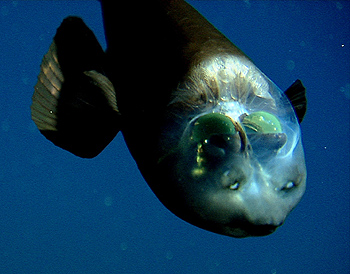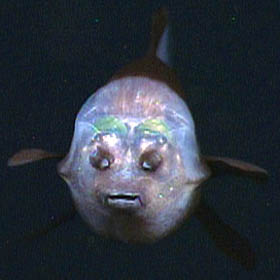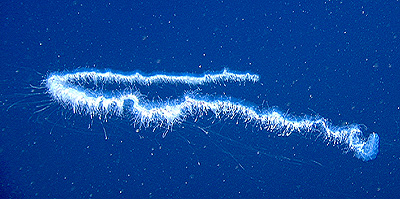Researchers at the Monterey Bay Aquarium Research Institute recently solved the half-century-old mystery of a fish with tubular eyes and a transparent head. Ever since the “barreleye” fish Macropinna microstoma was first described in 1939, marine biologists have known that it’s tubular eyes are very good at collecting light. However, the eyes were believed to be fixed in place and seemed to provide only a “tunnel-vision” view of whatever was directly above the fish’s head. A new paper by Bruce Robison and Kim Reisenbichler shows that these unusual eyes can rotate within a transparent shield that covers the fish’s head. This allows the barreleye to peer up at potential prey or focus forward to see what it is eating.
Deep-sea fish have adapted to their pitch-black environment in a variety of amazing ways. Several species of deep-water fishes in the family Opisthoproctidae are called “barreleyes” because their eyes are tubular in shape. Barreleyes typically live near the depth where sunlight from the surface fades to complete blackness. They use their ultra-sensitive tubular eyes to search for the faint silhouettes of prey overhead.

In this image, you can see that, although the barreleye is facing downward, its eyes are still looking straight up. This close-up “frame grab” from video shows a barreleye that is about 140 mm (six inches) long. Image: © 2004 MBARI
Although such tubular eyes are very good at collecting light, they have a very narrow field of view. Furthermore, until now, most marine biologists believed that barreleye’s eyes were fixed in their heads, which would allow them to only look upward. This would make it impossible for the fishes to see what was directly in front of them, and very difficult for them to capture prey with their small, pointed mouths.
Robison and Reisenbichler used video from MBARI’s remotely operated vehicles (ROVs) to study barreleyes in the deep waters just offshore of Central California. At depths of 600 to 800 meters (2,000 to 2,600 feet) below the surface, the ROV cameras typically showed these fish hanging motionless in the water, their eyes glowing a vivid green in the ROV’s bright lights. The ROV video also revealed a previously undescribed feature of these fish–its eyes are surrounded by a transparent, fluid-filled shield that covers the top of the fish’s head.

This face-on view of a barreleye shows it’s transparent shield lit up by the lights of MBARI’s remotely operated vehicle Tiburon. As in the other photos, the two spots above the fish’s mouth are are olfactory organs called nares, which are analogous to human nostrils. Image: © 2006 MBARI
Most existing descriptions and illustrations of this fish do not show its fluid-filled shield, probably because this fragile structure was destroyed when the fish were brought up from the deep in nets. However, Robison and Reisenbichler were extremely fortunate–they were able to bring a net-caught barreleye to the surface alive, where it survived for several hours in a ship-board aquarium. Within this controlled environment, the researchers were able to confirm what they had seen in the ROV video–the fish rotated its tubular eyes as it turned its body from a horizontal to a vertical position.
In addition to their amazing “headgear,” barreleyes have a variety of other interesting adaptations to deep-sea life. Their large, flat fins allow them to remain nearly motionless in the water, and to maneuver very precisely (much like MBARI’s ROVs). Their small mouths suggest that they can be very precise and selective in capturing small prey. On the other hand, their digestive systems are very large, which suggests that they can eat a variety of small drifting animals as well as jellies. In fact, the stomachs of the two net-caught fish contained fragments of jellies.
After documenting and studying the barreleye’s unique adaptations, Robison and Reisenbichler developed a working hypothesis about how this animal makes a living. Most of the time, the fish hangs motionless in the water, with its body in a horizontal position and its eyes looking upward. The green pigments in its eyes may filter out sunlight coming directly from the sea surface, helping the barreleye spot the bioluminescent glow of jellies or other animals directly overhead. When it spots prey (such as a drifting jelly), the fish rotates its eyes forward and swims upward, in feeding mode.

MBARI researchers speculate that Macropinna microstoma may eat animals that have been captured in the tentacles of jellies, such as this siphonophore in the genus Apolemia. The “head” of the siphonophore (at right) pulls the animal through the water, its stinging tentacles streaming out like a living drift net. Image: © 2001 MBARI
Barreleyes share their deep-sea environment with many different types of jellies. Some of the most common are siphonophores (colonial jellies) in the genus Apolemia. These siphonophores grow to over 10 meters (33 feet) long. Like living drift nets, they trail thousands of stinging tentacles, which capture copepods and other small animals. The researchers speculate that barreleyes may maneuver carefully among the siphonophore’s tentacles, picking off the captured organisms. The fish’s eyes would rotate to help the fish keep its “eyes on the prize,” while its transparent shield would protect the fish’s eyes from the siphonophore’s stinging cells.
Robison and Reisenbichler hope to do further research to find out if their discoveries about Macropinna microstoma also apply to other deep-sea fish with tubular eyes. The bizarre physiological adaptations of the barreleyes have puzzled oceanographers for generations. It is only with the advent of modern underwater robots that scientists have been able to observe such animals in their native environment, and thus to fully understand how these physical adaptations help them survive.
Video of barreleye narrated by Bruce Robison:
A fish with a transparent head. That sounds something straight out of science fiction but, it is everything but science fiction. A fish like that actually exists and lurks in the depths of the Pacific Ocean. Known as the Barreleye Fish, it is a true miracle of Nature. You won’t believe until you actually see it. So, without further ado, let us delve deep into the information about this ‘unbelievable’ creature. We are pretty sure you are going to love these Barreleye Fish facts.
Before we start…
| Kingdom | Animalia |
| Phylum | Chordata |
| Class | Actinopterygil |
| Order | Argentiniformes |
| Family | Opisthoproctidae |
| Scientific Name | Macropinna macrostoma |
Barreleye Fish Facts: 1-5 | Discovery
1. Chapman – a marine biologist – was the first person who discovered the Barreleye Fish back in 1939. Unfortunately however, till 2004 no one knew that it had a transparent head.
2. When the fish was being dragged up after being caught on nets, the transparent portion of the head was destroyed simply because it was too fragile.
3. The first ever photograph of the fish showing its transparent head was taken in 2004.
4. Later when technology evolved, scientists were capable of not only capturing the fish in its natural environment but also managed to capture a few specimen.
5. Reisenbichler and Robinson were the two researchers from Monterey Bay Aquarium Research Institute who studied the fish in its natural environment and captured one specimen and studied it in an aquarium.
Barreleye Fish Facts: 6-10 | Description – Head and Eyes
6. The Barreleye Fish has one of the most unusual appearance among deep sea creatures. The first thing that one notices is its dome-shaped head that is transparent on the top.
7. Inside the dome (which is actually filled with clear fluid) are its two barrel-shaped or tubular eyes that are embedded inside the head. They remain pointed upward. It was previously believed that the eyes were fixed in that position.
8. Closer examination of the fish revealed that its eyes can actually rotate inside the transparent dome-shaped head, allowing them to look straight ahead and not just upward.
9. These tubular eyes of the fish are known to be ultra sensitive and have a green fluid that is capable of capturing the tiniest bit of light at the great depths at which it lives. It is believed that the fish can filter out whatever sunlight gets through and allow the fish to bioluminescent light emitted by jellies and other sea creatures.
10. The eyes stay pointed upward when the fish looks for food. The eyes point forward when the fish feeds.
Barreleye Fish Facts: 11-15 | Mouth, Nostrils, Adaptations
11. The mouth of the Barreleye Fish is very small, suggesting that it is very picky when it comes to the prey. The small mouth won’t allow the fish to eat big prey.
12. The small mouth is a pointed snout. There are no teeth present in the mouth. The body of the fish is dark brown in color with large silvery fins.
13. Right above its mouth are two small eye-like spots. However, they aren’t the eyes. They are actually olfactory organs of the fish. If we try to draw and analogy, those are similar to human nostrils.
14. One of the most incredible adaptations of the Barreleye Fish is that they have large and flat fins. These fins allow the fish to stay absolutely motionless in deep waters.
15. While the fins allow it to stay absolutely motionless, the fins are also designed to give them the ability of precise maneuvers which hunting for food.
Barreleye Fish Facts: 16-20 | Hunting
16. Barreleye Fish are ambush predators. They stay motionless in water at great depths and look upward. Their specially designed eyes give them a binocular vision.
17. First, their specially designed eyes allow them to clearly distinguish between ambient light and bioluminescent light. This is possible because of the high number of rod cells that they have in their eyes.
18. Second, when the prey is located high up, the fish uses its binocular vision to narrow in on the prey using precise maneuvers with aid of its fins. It moves up vertically to reach its prey.
19. It is believed that the Barreleye Fish is actually steals food from siphonopores. Scientists believe that small creatures that are trapped in the stingy tentacles of the siphonopores are spotted by Barreleye Fish and then using its precise maneuvers, the fish steals the food from the siphonopores.
20. What about the sting that the tentacles of the siphonopores can gives? Scientists say that the fluid-filled transparent head protects the eyes of the Barreleye Fish from those stings and the fins allow the fish to maneuver between the tentacles of the siphonopores.
Barreleye Fish Facts: 21-25 | Diet, Behavior, Reproduction
21. What does the Barreleye Fish eat? Scientists have actually examined the stomachs of this fish and found remains of cnidarian animals (a phylum with over 10,000 animal species) and jellyfish.
22. Upon closely studying the fish’s visceral anatomy, scientists have come to a conclusion that the diet of the Barreleye Fish is quite broad including zooplankton that include both gelatinous and crustacean variants, tentacles and nematocysts of siphonopores, small fish etc.
23. Coming to the behavior of Barreleye Fish, these are solitary creatures. They are not social and will stay still and motionless with eyes looking upward, scanning prey.
24. Coming to the reproductive behavior, Barreleye Fish are thought be pelagic spawners. This means that females will lay eggs in water and males will release sperms in water.
25. The eggs get fertilized in water. The fertilized eggs are planktonic in nature and they are buoyant in nature. They will float around in shallow depths and drift with currents. As they grow into adults, they will gradually move at greater depths.
Barreleye Fish Facts: 26-30 | Predators, Habitat, Size
26. Scientists are yet to find whether they have any predators or not. However, as the rule of thumb goes, every living creature has a predator and hence, it is expected that even Barreleye Fish has predators. It is only a matter of time before scientists find out.
27. Barreleye Fish is a deep water fish. It is usually found at a depth of 2,000 feet to 2,600 feet but they can also be found at depths of 3,330 feet.
28. This fish is found in the three major oceans of the world – the Pacific Ocean, the Atlantic Ocean and the Indian Ocean.
29. Barreleye Fish is not very big. The average size is around 15 centimeters (6 inches), the species can grow up to 44 centimeters or (~17.3 inches).
30. Barreleye Fish Fun Fact: The fish lacks lateral vision. That is, it cannot see sideways. It can see upward and forward. This happens because of the way the eyes are fixed allowing only a forward and upward swivel movement. And yes, the fish lacks cone cells.








0 Comments